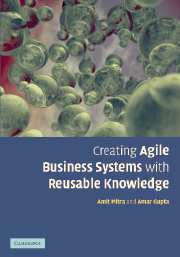Book contents
- Frontmatter
- Contents
- List of boxes
- List of figures
- List of tables
- Foreword
- Preface
- Acknowledgements
- Introduction
- 1 On the nature of reality and the nature of business
- 2 The object at the root of it all
- 3 The nature of attributes
- 4 Domains and their expression
- Appendix: Key shared components of knowledge
- Bibliography
- Index
Introduction
Published online by Cambridge University Press: 11 September 2009
- Frontmatter
- Contents
- List of boxes
- List of figures
- List of tables
- Foreword
- Preface
- Acknowledgements
- Introduction
- 1 On the nature of reality and the nature of business
- 2 The object at the root of it all
- 3 The nature of attributes
- 4 Domains and their expression
- Appendix: Key shared components of knowledge
- Bibliography
- Index
Summary
What is this book about and who should read it?
This book is about facilitating change with component technology, but is different from most approaches to the topic. The components in the book are not traditional I/T components. Rather they are shared components of knowledge from which patterns of business knowledge are assembled. A fundamental premise of this paradigm is that meanings are patterns of information, abstract structures that may be derived from other components, which are also meanings. If we can identify and describe these components and their structures with precision, we can automate the process. Business processes and information systems configured from these components will be extremely flexible, configurable, and coordinated.
This book lays the foundation of a new computing paradigm – a paradigm in which computers manipulate meanings, not program code or blind symbols. Computers of the future, built on the principles described in the book, will operate on the plane of meanings – a little like we do.
Business meanings, patterns, and rules jointly constitute the substance of a business process. Without the business layer, technological standards have little meaning. The return on investment from reusing business knowledge can complement, and be orders of magnitude larger than by adherence to technical standards alone. This book establishes a framework for the transfer and reuse of business knowledge in different contexts. This is why we urge architects interested in service oriented architecture and business process management to read this book. This book is for information and process architects.
- Type
- Chapter
- Information
- Publisher: Cambridge University PressPrint publication year: 2007

